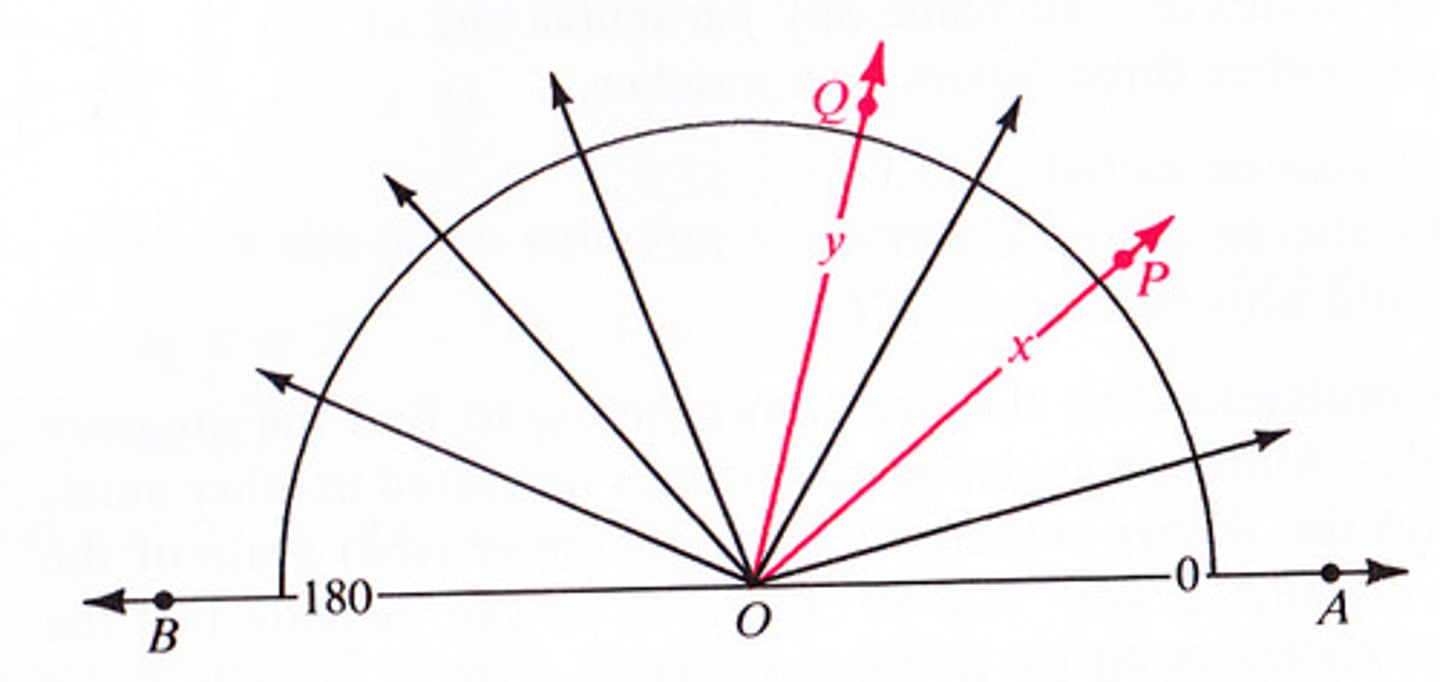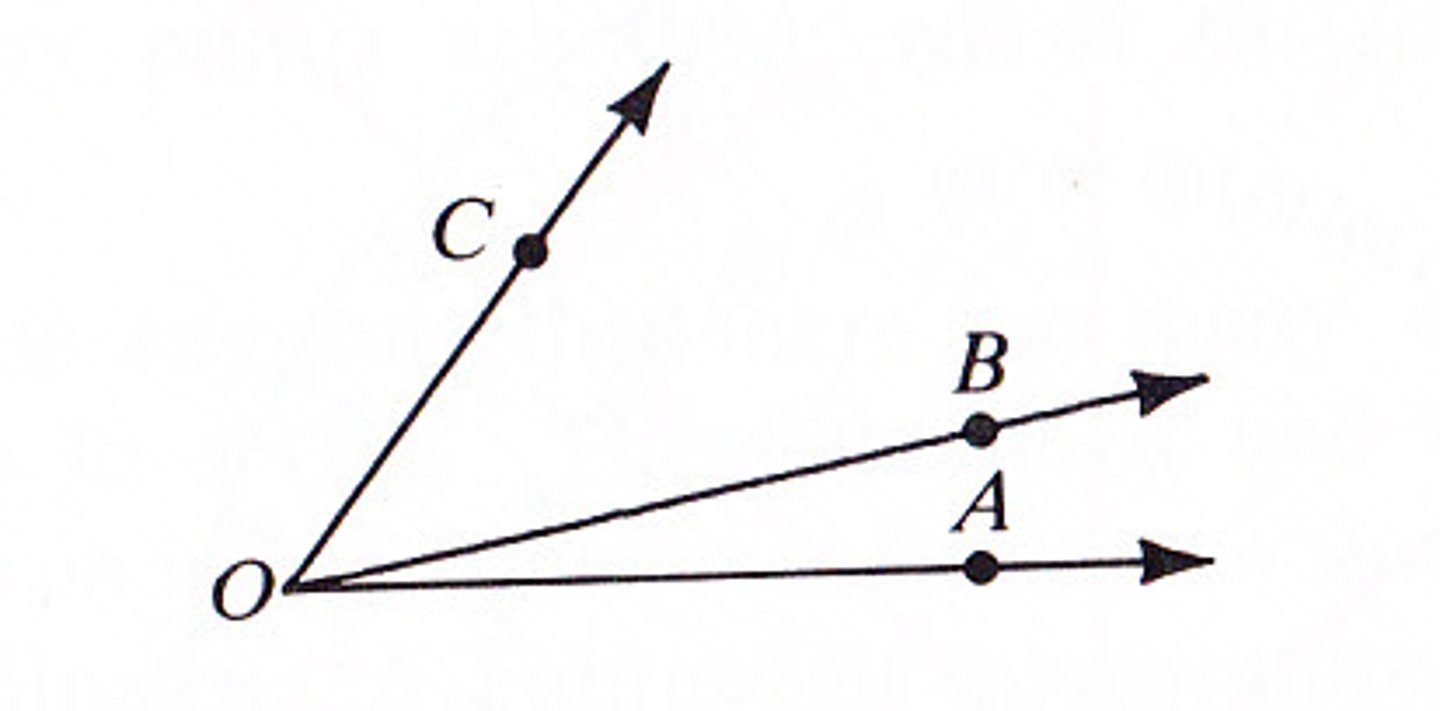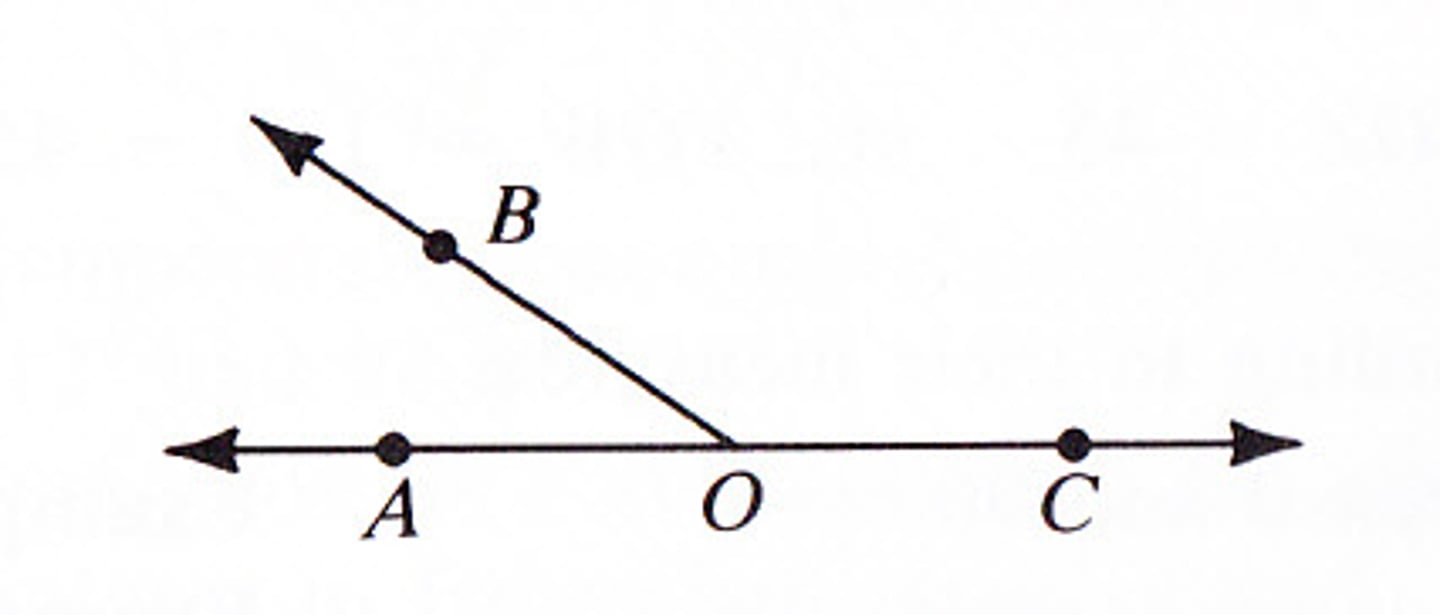Geometry Jurgensen Chapters 1-5, Geometry
1/116
There's no tags or description
Looks like no tags are added yet.
Name | Mastery | Learn | Test | Matching | Spaced |
|---|
No study sessions yet.
117 Terms
a line that intersects two or more coplanar lines in different points
Transversal
(trans.)
two nonadjacent interior angles on opposite sides of a transversal
Alternate Interior Angles
(alt. int. ⦞)
two interior angles on the same side of a transversal
Same-side Interior Angles
(s-s. int. ⦞)
two angles in corresponding positions relative to the two lines
Corresponding Angles
(corr. ⦞)
parallelogram
A quadrilateral with both pairs of opposite sides parallel
Five ways to Prove that a quadrilateral is a parallelogram
1. Show that both pairs of opposite sides are parallel
2. Show that both pairs of opposite sides are congruent
3. Show that one pair of opposite sides are both congruent and parallel
4. Show that both pairs of opposite angles are congruent
5. Show that diagonals bisect each other
Rectangle
a quadrilateral with four right angles; is always a parallelogram
Rhombus
a quadrilateral with four congruent sides; is always a parallelogram
Square
A quadrilateral with four right angles and four congruent sides. Is always a rectangle, a rhombus, and a parallelogram.
Trapezoid
a quadrilateral with exactly one pair of parallel sides
Isosceles trapezoid
a trapezoid with congruent legs
Polygon
A closed geometric figure in a plane formed by connecting line segements endpoint to endpoint with each segment intersecting exactly two others. No tow segments with a common endpoint are collinear.
Convex polygon
a polygon such that no line containing a side of the polygon contains a point in the interior of the polygon
Diagonal
a segment that joins two nonconsecutive vertices
Regular polygon
a polygon that is both equilateral and equiangular
Triangle
figure formed by 3 segments joining 3 noncollinear points
Vertex of triangle
each of the 3 points joining the sides of a triangle
Sides of triangle
the sides of a triangle are the segments that make up the triangle
Vertices
plural of vertex
Scalene triangle
a triangle with no congruent sides
Isosceles triangle
A triangle with at least two congruent sides
Equilateral triangle
a triangle with all sides congruent
Acute triangle
A triangle with three acute angles
Obtuse triangle
a triangle with one obtuse angle
Right triangle
a triangle with one right angle
Equiangular triangle
a triangle with all angles congruent
Auxiliary line
line (or ray or segment) added to a diagram to help in a proof; *shown as a dashed line
Remote interior angles
the two nonadjacent interior angles corresponding to each exterior angle of a triangle
Exterior angle
an angle formed by one side of a triangle and the extension of another side
Postulate 11
if two lines are cut by a transversal and the corresponding angles are congruent, then the lines are parallel
Parallel lines
coplanar lines that do not intersect
Parallel planes
planes that do not intersect
Alternate interior angles
two nonadjacent interior angles on opposite sides of the transversal; (to find alternate interior angles, look for the letter "Z" or backwards "Z")
Same-side interior angles
two interior angles on the same side of the transversal; (to find same-side interior angles, look for a square "C" or backwards square"C")
Corresponding angles
two angles in corresponding positions relative to the two lines; (To find corresponding <'s, look for the letter "F" or backwards "F, or upsidedown "F")
Median of a triangle
A segment from a vertex to the midpoint of the opposite side
Altitude of a triangle
the perpendicular segment from a vertx to the line containing the opposite side
Perpendicular bisector of a segment
a segment, ray, line, or plane that is perpendicular to a segment at its midpoint
hypotenuse
the side of a right triangle opposite the right angle
Leg-Leg Method (LL)
If two legs of one right triangle are congruent to the two legs of another right triangle, then the triangles are congruent.
Hypotenuse-Acute Angle Method (HA)
If the hypotenuse and an acute angle of one right triangle are congruent to the hypotenuse and an acute angle of another right triangle, then the triangles are congruent.
Leg-Acute Angle Method (LA)
If a leg and an acute angle of one right triangle are congruent to the corresponding parts in another right triangle, then the triangles are congruent.
SSS Postulate
if three sides of one triangle are congruent to three sides of another triangle, then the triangles are congruent
SAS Postulate
if two sides and the included angle of one triangle are congruent to two sides and the included angle of another triangle, then the triangles are congruent
ASA Postulate
if two angles and the included side of one triangle are congruent to two angles and the included side of the second, the triangles are congruent
Congruent triangles
Two triangles are congruent if and only if their vertices can be matched up so that all of their corresponding parts (sides and angles) are equal
Congruent polygons
Two polygons are congruent if and only if their vertices can be matched up so that their corresponding parts are congruent.
Non coplanar
Not in the same plane
Equidistant
equally distant from two points
set of all points
Space
Undefined terms
Point, line, plane
Collinear
lying on the same line
Coplanar
lying in the same plane
then their intersection is a line.
If two planes intersect,
Through any two points there is
Exactly one line
two
A line contains at least ____ points. (a)
set of points that are in both figures
Intersection
four
Space contains at least ____ points, not all in the same plane. (a)
then the line that contains the points is in that plane.
If there are two points in a plane,
distance between two points;
found by taking the absolute value of the difference of the coordinates of the two points
Length (distance is always positive)
there is at least one plane.
(c) Through any three points
the number that is paired with a particular point on a number line
Coordinate
three
A plane contains at least ____ points, not all in one line. (a)
Through any three non collinear points there is
Exactly one plane. (If the points are collinear, then an infinite number of planes might intersect them.)
If two lines intersect then
Exactly one plane contains the lines
point that divides the segment into two congruent segments
Midpoint
(midpt.)
a line, ray, or plane that intersects the segment at its midpoint
Definition of a Segment Bisector
Ray
A straight line extending from a point
two rays that have the same endpoint, and the endpoint lies between the two second points
Opposite Rays
Angle
Consists of two rays (sides) and a common endpoint (vertex).
angle with measure greater than 90° and less than 180°
Obtuse Angle
Acute angle
an angle less than 90 degrees but more than 0 degrees
angle with measure of 180°
Straight Angle
angles that have equal measures
Congruent Angles
(≅ ⦞)
unique positive number ≤ 180° that is paired with the angle
Measure of an Angle
(m∠)
two objects that have the same size and shape
Congruent
(≅)
Right angle
an angle that measures 90 degrees
a ray that divides an angle into two congruent adjacent angles
Definition of an Angle Bisector (the smaller parts are equal to EACH OTHER)
segments that have equal length
Congruent Segments
(≅ seg.)
Congruent angles
angles that have the same measure
Adjacent angles
are a pair of angterm-19les with a common vertex and a common side, but no common interior points
Postulate
A statement that can be taken as fact without being proven.
1. The points on a line can be paired with the real numbers in such a way that any two points can have coordinates 0 and 1.
2. Once a coordinate system has been chosen this way, the distance between any two points equals the absolute value of the differencde4 of their coordinates.
Ruler Postulate
If B is between A and C, then:
AB + BC = AC.
Segment Addition Postulate
On line AB in a given plane, choose any point O between A and B. Consider ray OA and ray OB and all other rays that can be drawn on one side of line AB. These rays can be paired with the real numbers from 0 to 180 in such a way that:
a. ray OA is paired with 0 and ray OB with 180.
b. If ray OP is paired with x, and ray OQ is paired with y, then
m ∠ POQ = Ιx-yΙ
Protractor Postulate

If point B lies in the interior if ∠AOC then
m∠AOB + m∠BOC = m∠AOC.
Angle Addition Postulate - part 1

If ∠AOC is a straight angle and B is any point not on line AC, then
m∠AOB + m∠BOC = 180
Angle Addition Postulate - part 2

If line segment DE ≅ line segment FG, then
line segment FG ≅ line segment DE.
If ∠ D ≅ ∠ E, then
∠ E ≅ ∠ D.
Symmetric Property (properties of congruence)
If line segment DE ≅ line segment FG and line segment FG ≅ line segment JK, then
line segment DE ≅ line segment JK.
If ∠ D ≅ ∠ E and ∠ E ≅ ∠ F, then
∠ D ≅ ∠ F.
Transitive Property (properties of congruence)
a(b+c) = ab + ac
Distributive Property (algebra - properties of equality)
an angle that makes another angle total 90°
Complement
(comp.)
two angles whose measures have the sum 90°
Complementary Angles
(comp. ⦞) (Do not need to be adacent)
coplanar lines that do not intersect
Parallel Lines
(∥ lines)
planes that do not intersect
Parallel Planes
(∥ planes)
lines, rays, or segments that intersect to form right angles
Perpendicular
(⊥)
an angle that makes another angle total 180
Supplement
(supp.)
two angles whose measures have the sum 180°
Supplementary Angles
(supp. ⦞) (Do not need to be adjacent)
Addition Property of Equality
If you add the same number to each side of an equation, the results are equal; If A = B, then A + C = B + C
Subtraction Property of Equality
If you subtract the same number from each side of an equation, the two sides remain equal; If A = B, then A - C = B - C
Multiplication Property of Equality
If you multiply each side of an equation by the same number, the two sides remain equal; If A = B, then AC = BC